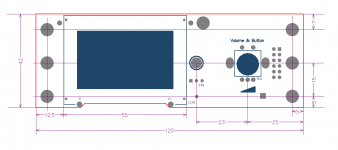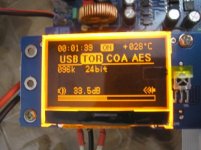The temperature sensor is included in MCU, so I just don't want to waste it.
Me want
any idea to improve?
I'd recommend detaching the LCD and the control knob from the PCB (e.g., connecting them with wires and Molex plugs), so they can be moved around and installed in different locations. If the screen and the knob are fixed in place, it'll be hard to make this panel unit look good in an aluminum case (remember, most of us don't have professional machining tools
Along the same lines: it would be useful if the LCD came with a metal frame that has screw holes. That way, it could be attached to the outside of a case and all you'd need to do is drill a small hole for the wires.
It may be too late to make these changes now . . . but it's stuff that would be cool to see in the next version (the "modular" one?
Along the same lines: it would be useful if the LCD came with a metal frame that has screw holes. That way, it could be attached to the outside of a case and all you'd need to do is drill a small hole for the wires.
It may be too late to make these changes now . . . but it's stuff that would be cool to see in the next version (the "modular" one?).
Yes, yes, yes! There's no point in having an LCD screen when you don't have the machinery to cut out room for it in an enclosure.
Last edited:
yes, I think lcd can display more infomation, but need more time to finish.
Optical and coaxial accept 96kHz/24bit and usb 48khz/16bit.
1st thing you need to remember is that the display must be visible for a distance, I.E. 3 meters app. Too small font will make it useless as you have to get up every time just to see what it is displaying.
2nd thing is the color of the LED. White is in my oppinion neutral although red or green is pleasing to the eyes at night if contrast allows it.
3rd Is there any way to dim the display or timer turn it off when not in use and watching movies?
4th is there no way to support 192khz/24bit material with this chip (or in general)?
any idea to improve?
The module idea is great as it minimizes your workload as you only need few basic boards and som controller, psu and display. However, is there any way to make it accept blu-ray formats like DTS-MA and DD-HD (maybe you set the player to decode but output PCM via coax?).
Hi all, I got the pcb and here is the first board.
I am totally amazed at the speed you are doing things at. Producing new boards at record pace (compared to the typical DIY pace anyways
Please do let me/us know if you want to brainstorm future features before jumping into production. I personally have no degree in electronics, but am very interested with clear goals for the product I might buy (was your 2050 v2 until you started this project with the 5.1 in the distance
Is there any way to dim the display or timer turn it off when not in use and watching movies?
I'd argue that this feature is more important than either the color of the LCD or the size of the text on it. A single bright LED in the wrong place can be annoying, so an overly bright LCD display would be a serious design mistake.
An "auto off" setting for the display will probably suit most people, who will rarely touch the controls after they've finished configuring the amp. The DIYers who want their display to be as noticeable as possible (to impress others?
Very useful suggestions. I think some of the ideas are already on the way.1st thing you need to remember is that the display must be visible for a distance, I.E. 3 meters app. Too small font will make it useless as you have to get up every time just to see what it is displaying.
2nd thing is the color of the LED. White is in my oppinion neutral although red or green is pleasing to the eyes at night if contrast allows it.
3rd Is there any way to dim the display or timer turn it off when not in use and watching movies?
4th is there no way to support 192khz/24bit material with this chip (or in general)?
The module idea is great as it minimizes your workload as you only need few basic boards and som controller, psu and display. However, is there any way to make it accept blu-ray formats like DTS-MA and DD-HD (maybe you set the player to decode but output PCM via coax?).
I am totally amazed at the speed you are doing things at. Producing new boards at record pace (compared to the typical DIY pace anyways).
Please do let me/us know if you want to brainstorm future features before jumping into production. I personally have no degree in electronics, but am very interested with clear goals for the product I might buy (was your 2050 v2 until you started this project with the 5.1 in the distance).... and of course financial support once the project is ready for shipping
.
For DTS and DD, I'm also have some idea, but will not in this one.
I will post my work before public it.
I think we will support 192kHz when balance input, but before making sure, I have to test more.I also think that support up to 24/192 would be great! Especially if balanced input is supported
I'd argue that this feature is more important than either the color of the LCD or the size of the text on it. A single bright LED in the wrong place can be annoying, so an overly bright LCD display would be a serious design mistake.
An "auto off" setting for the display will probably suit most people, who will rarely touch the controls after they've finished configuring the amp. The DIYers who want their display to be as noticeable as possible (to impress others?) can always disable this feature.
I agree too. So the back-light of LCM will be auto-off when there is no setup action.
I am also excited about this new amp, curious to hear how it sounds. I'm thinking about wouldn't it be awesome if we had 4 or 6 channels and could set the crossover digital. Then we could run one channel to each speaker element (2 or 3 way) without using any analoge crossover. I guess the level would need to be adjusted between the channels also.
Anyone tried this with another setup?
Anyone tried this with another setup?
I am also excited about this new amp, curious to hear how it sounds. I'm thinking about wouldn't it be awesome if we had 4 or 6 channels and could set the crossover digital. Then we could run one channel to each speaker element (2 or 3 way) without using any analoge crossover. I guess the level would need to be adjusted between the channels also.
Anyone tried this with another setup?
That sounds like what I read about the apogee amp (from the klipsch omnisphere Xbox xpeakers). It is a very nice idea and all active xover, digital surround amp is my next big project
We need a hifimediy solution to his problem (make it modular to suit more people than me
http://www.diyaudio.com/forums/class-d/132361-spherex-class-d-amps-ebay.html and http://www.diyaudio.com/forums/class-d/124598-full-digital-amp.html to those interested.
Maybe a little inspiration
Maybe a little inspiration
Looks great so far. I'm pretty amazed at the pace of your progress with this.
+1

a stupid comment as a pretext to follow-up this topic 
3 digits for temperature display (028°C in the above example) is overkill i guess. We don't expect it to go over 99°C display simply 28°C would be nicer.
display simply 28°C would be nicer.
hifimediy, keep up good work If this sounds as good as your AMT2050 v2 amp with a DAC, you'll rule the world
If this sounds as good as your AMT2050 v2 amp with a DAC, you'll rule the world 
3 digits for temperature display (028°C in the above example) is overkill i guess. We don't expect it to go over 99°C
hifimediy, keep up good work
- Status
- This old topic is closed. If you want to reopen this topic, contact a moderator using the "Report Post" button.
- Home
- Vendor's Bazaar
- Another project, all digital DDX amplifier

